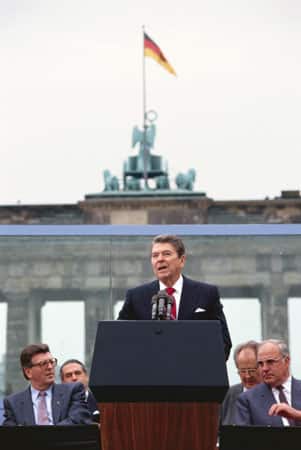In 1989, the Cold War was declared officially over at a meeting between the U.S.A. and U.S.S.R.- Who Won?
“The end of the Cold War is our common victory”- Mikhail Gorbachev
“Ronald Reagan had a higher claim than any other leader to have won the Cold War for liberty and he did it without a shot being fired.”- Margaret Thatcher, former Prime Minister of Britain
- Mikhail Gorbachev became the General Secretary on March 10, 1985, after the death of Konstantin Chernenko.
- Gorbachev was the party’s first leader to be born after the Russian revolution and was educated after the Stalin era. Therefore, he had vastly different ideas on ruling the Soviet Union.
- Gorbachev realized that the Russian economy was in a state of such despair, that it was imperative that the economy was restructured and modernized.
- Gorbachev’s desire for change and reform led to the implementation of Perestroika (restructuring) and Glasnost (openness) in the 1980s
- U.S.-Soviet relations also improved considerably during the middle 1980s due to the four summit meetings between President Regan and Gorbachev.
- At the meeting in Reykjavik, Iceland, in October 1986, Gorbachev proposed a 50% reduction in the nuclear arsenals of each side, which showcased the immense change in the attitudes of the Soviet leadership toward the US.
- For a time it seemed as though a historic agreement would be reached however the summit ended in failure, owing to differences over SDI.
- President Regan refused to abandon the SDI program, however, on December 8, 1987, the Intermediate Nuclear Forces (INF) Treaty was signed in Washington, eliminating an entire class of nuclear weapons.
- The INF Treaty was the first arms-control pact to require an actual reduction in nuclear arsenals rather than merely restricting their proliferation.
- As the 1980s came to an end, much of the Eastern Bloc began to crumble.
- In September 1987 Erich Honecker became the first East German head of state to visit West Germany.
- In 1989, the Hungarian government took down the barbed wire on its border with Austria and the West. The Soviet Union did nothing in response. Although travel was still not completely free, the Iron Curtain was starting to unravel.
- Another sign of Glasnost and perestroika was the fact that there were elections in Russia for the first time ever. The citizens got to vote for the people’s deputies and 20% of the communist provincial deputies were not selected. The people did not receive a backlash at this, signifying the change that was sweeping through the USSR.
- On November 10, 1989, one of the most famous symbols of the Cold War came down: the Berlin Wall. By the end of the year, leaders of every Eastern European nation except Bulgaria had been ousted by popular uprisings.
- By mid-1990, many of the Soviet republics had declared their independence. Turmoil in the Soviet Union continued, as there were several attempts at overthrowing Gorbachev.
- On December 8, 1991, the Soviet Union ceased to exist. Boris Yeltsin, president of the Russian Republic, formed the Commonwealth of Independent States (C.I.S.). After 45 years, the Cold War was over.
